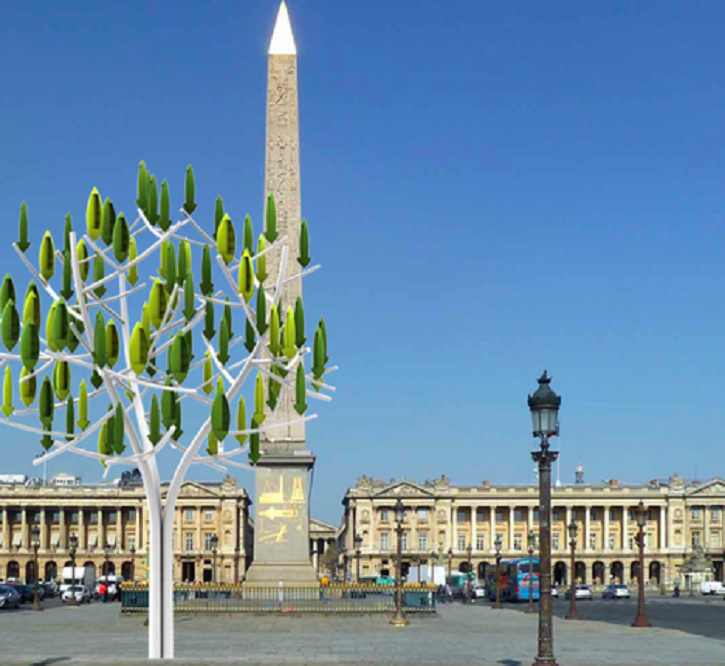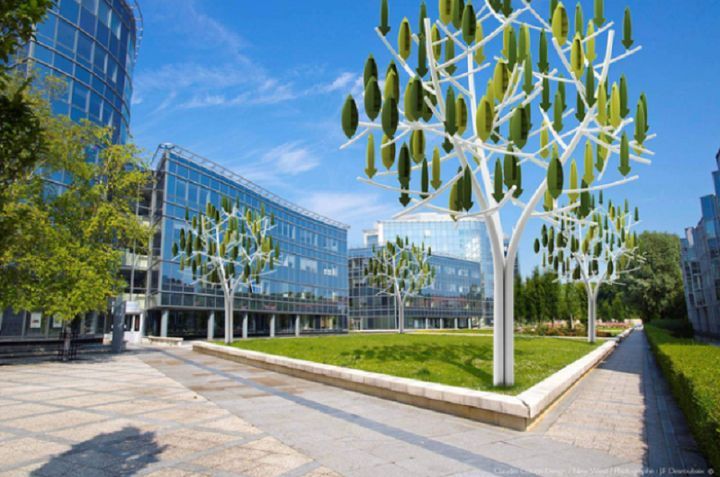
Wind power is considered one of the best forms of renewable energy, second only to solar when it comes to clean and sustainable alternatives. As of 2014, wind energy production made up around 4% of total worldwide demand, and is growing rapidly. Unfortunately, the fact that they perform better when they are large and positioned up high - coupled with large, unsightly rotors - means that wind farms are relegated to the countryside or out to sea.
As a result, small wind operations are not being built closer to town, where - in conjunction with solar panels and other alternative means - they could provide additional power to homes and buildings and reduce their reliance on central grids. Luckily, a French entrepeuner may have the solution - a small-scale wind turbine that look just like a tree!
What are Wind Trees?
Known as the "Wind Tree" (or Tree Vent, in French), this wind turbine could lead to wider adoption of wind power in urban centers, where they would be able to make use of low winds that circulate around buildings and streets. Invented by Jérôme Michaud-Larivière, who founded the French company New Wind to bring it to market, these trees rely on a series of 72 vertical-axis micro-turbines (known as Aeroleafs) to generate power from gentler winds.

Jérôme Michaud-Larivière, founder and CEO of New Wind, holding an Aeroleaf. Credit: New Wind
Each tree is 11 meters (36 feet) tall and 8 meters (26 feet) in diameter at its widest point, which lends it the same dimensions and many urban trees. According to Michaud-Larivière, the tree can harness breezes blowing as slowly as two meters per second - 7 km/h (4.4 mph) - making it twice as sensitive as traditional turbines and useful across more than 280 days of the year.
However, they are also durable enough to withstand Category 3 winds, which can reach 178 - 208 km/h (111-129 mph), and each unit has a power output of about 3.1 kW. This may seem modest on its own, but several trees groups together in parks or within green spaces between buildings could generate enough power to make a serioues difference. In addition, their orientation cancels out noise, with each turbine spinning silently.
Each turbine “sheet,” called an Aeroleaf, is constructed out of lightweight plastic. The plastic has been treated with a resin which protects it from weather conditions such as humidity and salt (which comes in handy if your a sea-side town). What's more, the turbines are wired in parallel so that if any one of them stops working, for whatever reason, the others will not be affected.

The first Wind Tree is scheduled to be installed in Paris at the Place de la Concorde in March 2015. Credit: New Wind
Wind Tree Uses
Compared to larger wind turbines, which generate considerably more power, the Wind Tree requires much less wind to begin generating electricity and is subject to much less variability. Their small size and noise-free nature also mean they can be mounted just about anywhere. And compared to turbines that rely on large wind blades, the Wind Tree is also considerably safer for wildlife.
And while it is not the first proposal to make use of vertical-axis rotors, the Wind Tree concept is far closer to being commercially realized. New Wind has already produced prototypes of the design, and the company is set to install one of them at the Place de la Concorde in Paris in March of 2015, a demonstration that the company claims will raise awareness about renewable energy in the city. If all goes well, they plan to embark on mass production by 2016.
Early estimates also place the cost per unit at about €29,500 (US$36,500). So while individual home owners may not yet be able to take advantage of this new technology, municipal governments and townships certainly will. For a one-time cost of a few hundred-thousands dollars, a city could look forward to significantly reducing its carbon footprint and ensuring a steady supply of clean, renewable energy.
And be sure to enjoy this video of the Wind Tree in action:
Top image: New Wind
Sources:
- www.newwind.fr/
- www.gizmag.com/wind-tree-fig-leaf-unsightly-turbines/35040/
- www.businessinsider.com/wind-turbines-that-look-like-trees-2015-1
- www.iflscience.com/technology/new-wind-turbine-looks-tree-coming-paris
- www.newsweek.com/new-tree-shaped-wind-turbine-be-installed-streets-paris-296591
- www.geek.com/science/new-wind-turbine-looks-like-a-tree-generates-power-silently-1612693/
- inhabitat.com/wind-energy-made-beautiful-with-these-silent-wind-tree-turbines/
- www.treehugger.com/wind-technology/beautiful-wind-turbine-trees-generate-clean-energy-urban-environments.html








